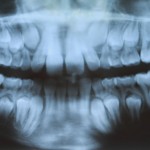
It is reported that around 13% of upper canines can be displaced, the majority of these being palatally displaced. Controversy exists on whether a closed techniques of moving a canine into its correct position beneath the palatal mucosa (closed technique) is preferential to an open technique which involves moving the canine into its correct position above the palatal mucosa (open technique). A 2008 Cochrane review (Parkin et al) investigated this question but identified no randomised trials addressing this question. This new multi-centre trial aimed to investigate differences in the periodontal outcomes of palatally displaced canines (PDC) exposed with either an open or a closed surgical technique
Patients with unilateral PDC were randomised to one of 2 surgical exposure techniques and treated in a hospital setting. The open surgical exposure, after exposure of the PDC and excision of the palatal mucosa, a surgical pack was sutured in place. After 10 days, the patient was re- viewed and the pack removed. For the closed surgical exposure, after uncovering of the PDC, an eyelet attachment with a gold chain was bonded to the palatal or buccal surface of the ectopic canine (whichever was the most accessible). Fixed appliances were placed either before or shortly after surgery. The main outcome was periodontal attachment level, which was recorded at baseline and 3 months after removal of the fixed appliances. Secondary outcomes were palatal gingival recession, crown height, and radiographic alveolar bone levels
- Data from 62 participants (closed, 29; open, 33) were analyzed.
- There was no difference in clinical attachment level between PDC exposed with an open vs a closed surgical technique (mean difference, 0.1 mm; 95% confidence interval [CI], -0.2-0.5).
- There was, a statistical difference in mean attachment loss between the operated and unoperated (contralateral) canines (mean difference, 0.5 mm; 96% CI, 0.4-0.7; P <0.001).
- Twenty of the 62 subjects had some recession on the palatal aspect of the operated canine, whereas only 4 subjects had some visible root surface on the palatal aspect on the unoperated side (P = 0.001).
The authors concluded
In this randomized clinical trial, we found that exposure and alignment of PDC has a small impact on periodontal health. The magnitude of this impact is not influenced by surgical technique (in terms of open vs closed exposure) and is so small that it is unlikely to influence the prognosis of a tooth in the long term in most patients.
Comment
This is a well-reported study with a good discussion of issues raised by the study. It also notes that the only other study currently available on this question is a retrospective study conducted more than 30 years ago ( Wisth et al 1976).
Links
Parkin NA, Milner RS, Deery C, Tinsley D, Smith AM, Germain P, Freeman JV, Bell SJ, Benson PE. Periodontal health of palatally displaced canines treated with open or closed surgical technique: A multicenter, randomized controlled trial. Am J Orthod Dentofacial Orthop. 2013 Aug;144(2):176-84. doi: 10.1016/j.ajodo.2013.03.016. PubMed PMID: 23910198.
Parkin N, Benson PE, Thind B, Shah A. Open versus closed surgical exposure of canine teeth that are displaced in the roof of the mouth. Cochrane Database of Systematic Reviews 2008, Issue 4. Art. No.: CD006966. DOI: 10.1002/14651858.CD006966.pub2.
Wisth PJ, Norderval K, Bøoe OE. Comparison of two surgical methods in combined surgical-orthodontic correction of impacted maxillary canines. Acta Odontol Scand. 1976;34(1):53-7. PubMed PMID: 1066949.

Open or closed surgical technique for displaced palatal canines did not affect periodontal outcomes … http://t.co/Rm54BTG9aa